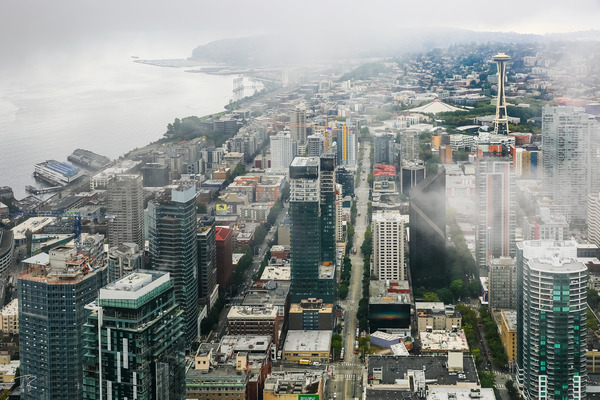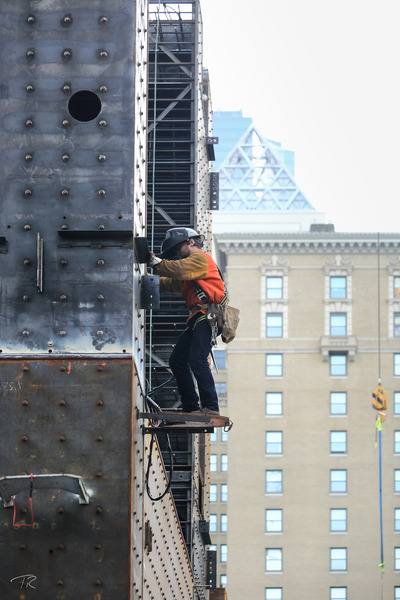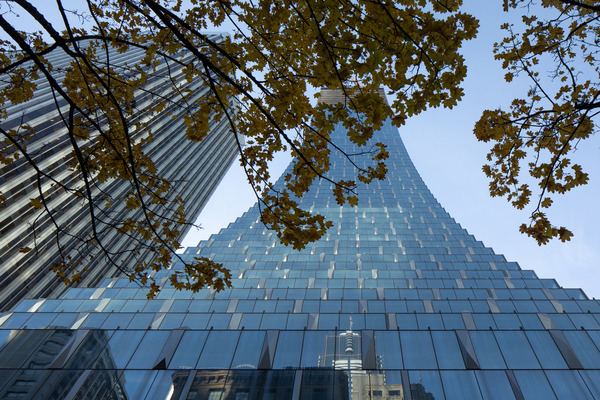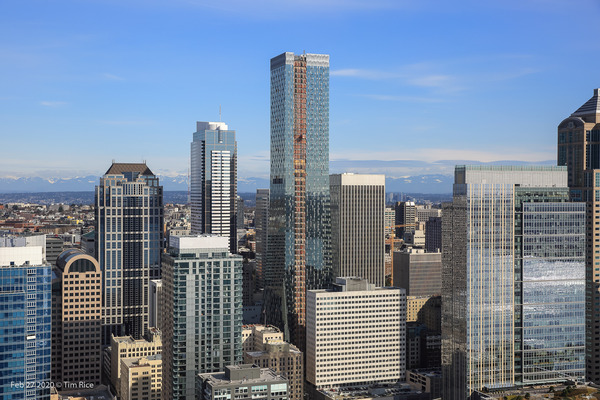Even from the corner of Third and Denny, over a mile north of Rainier Square, the tower looms large on the skyline. Over the last year, the tower has grown each day, and now the curtainwall has reached the top of the building, the crane has been dismantled, and from here, the project looks complete. There’s certainly no sign that this building hides a first-of-its-kind structural system that the team agrees represents an inflection point in how tall buildings are designed and built.
This is a monumental achievement from a design, construction and development perspective: visible from miles away; first new high-rise in the Metropolitan Tract in decades; super-tight site – only half a city block; located in a seismic zone; completely new structural system, nearly two decades in the making.
The building topped out in around 9 months, a major accomplishment that fulfilled predictions. With that in mind, it’s worth asking; what does this mean to the team and where does this innovative steel core concept go from here?
There are two things MKA, Wright Runstad, and Lewis all agree on: first, this isn’t the last time we’ll see a concrete-filled composite-plate shear wall (CF-CPSW). “We’re investigating the system for several projects on the West Coast,” says Brian Morgen, MKA’s Principal-in Charge of the project. Andy Bench, Wright Runstad’s Project Manager, states, “the schedule savings absolutely made this worthwhile.”
But second, there’s a lot of work to do before then. “We’ve got to do a full debrief and analysis as a team to define some parameters of where this system makes financial sense,” says Bart Ricketts, CEO of Lease Crutcher Lewis. This particular project’s tight site and seismic profile lent itself to a unique structural system, but it won’t be the same on every site, he says. “How can we refine the process? What are the project characteristics that make this system a good fit, and what are the things that make this pencil better than a traditional core?”
Ricketts and Morgen also agree on one other thing: this project’s success wouldn’t have been possible if the team didn’t have a culture focused on continuous improvement and innovation. “This is a project that shows the power of total team commitment, from the owner to the ironworkers. Everyone on the project had an appetite for calculated risk, and we all had the project’s interest at heart each step of the way,” says Ricketts.
He is also excited about the safety aspect of the CF-CPSW, which requires fewer trades working in the core area at any given time. For leading concrete cores, a project would typically have 25-30 tradespeople literally working on top of each other: ironworkers, concrete teams, and carpenters all working in the same building core space, resulting in trade congestion, communication and logistics complexities. For Rainier’s core, a single team of 6 welders worked the entire way up the core.

Ricketts and Morgen are clear, though, that this isn’t the magic bullet that will solve the high-rise world’s problems. Despite having several new projects using this core on the books already, Morgen thinks it’s going to take some time before the institutional desire from owners and contractors makes this a common construction method. “Lots of owners and contractors are taking a hard look at this, but not everyone is comfortable with the risk profile,” he says. Ricketts also emphasized that each project’s characteristics – not only the physical ones, like location, height and seismicity, but also the intangibles like team composition – need to be considered before declaring the system a good fit for the project.
For now, Morgen finds immense personal satisfaction whenever he sees the fully enclosed building…perhaps because it’s right outside his 32nd-floor office in the adjacent Rainer Tower. “I feel proud for the entire team every time I see it. This was a huge team effort.”
Ricketts echoes those remarks. “Rainier Square can be seen from just about anywhere in the city. I think every employee of Lewis and the rest of our project team partners should view it as a source of pride and impressive innovation.”

